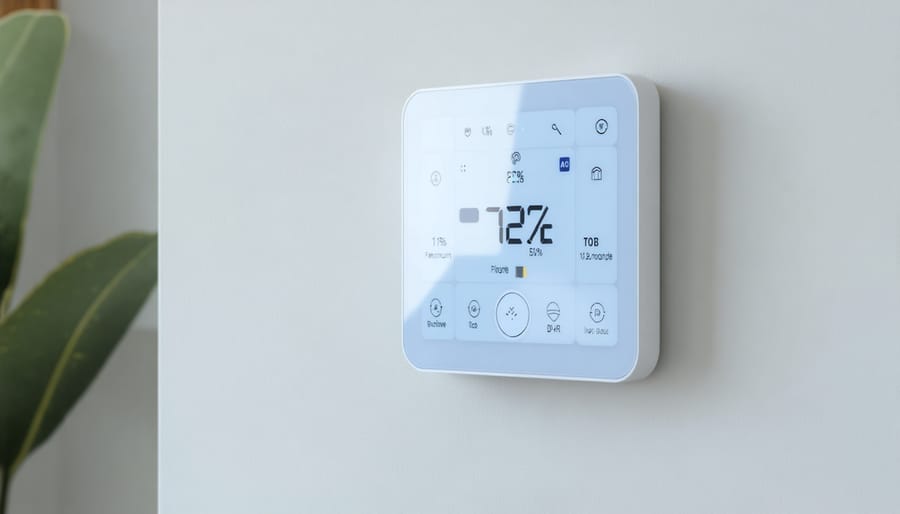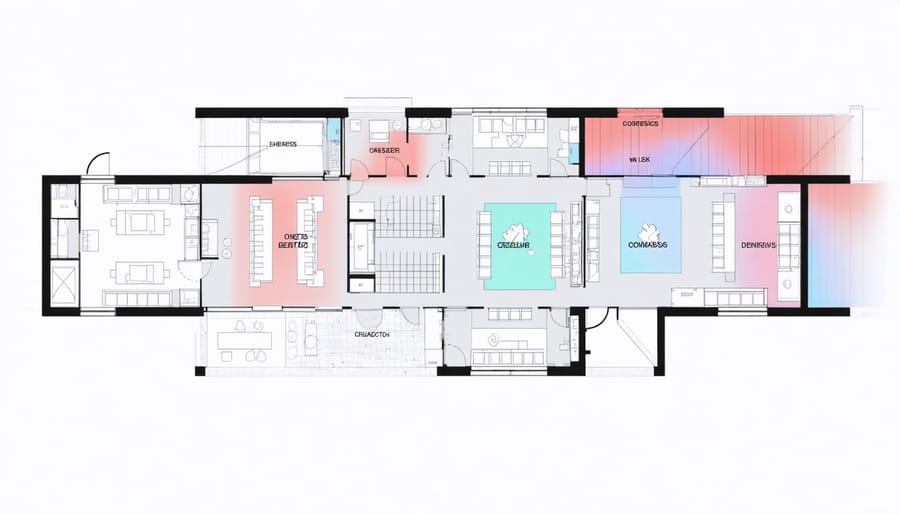Transform your living space into a year-round comfort zone with precision climate control rooms – the smart solution for maintaining perfect temperature, humidity, and air quality. Modern climate control technology puts unprecedented environmental mastery at your fingertips, combining sophisticated sensors, smart thermostats, and automated systems to create your ideal indoor atmosphere.
Gone are the days of battling seasonal discomfort or wrestling with multiple temperature zones. Today’s climate control rooms offer personalized comfort settings for every area of your home, from keeping your wine cellar at the perfect 55°F to maintaining optimal humidity in your home office. Whether you’re protecting valuable art collections, ensuring comfortable sleep environments, or maximizing energy efficiency, these systems deliver professional-grade climate management in a user-friendly package.
Learn how to design, implement, and maintain the perfect climate control system for your specific needs. From basic temperature regulation to advanced multi-zone solutions, this guide will walk you through everything you need to know about creating and managing your ideal indoor environment.
What Makes a Climate Control Room Smart?
Core Components
At the heart of every climate control room are three essential components that work together seamlessly. Smart thermostats serve as the brain of the system, allowing you to program temperature schedules, adjust settings remotely, and even learn from your preferences over time. These innovative devices often come with user-friendly touchscreen displays and smartphone connectivity, making temperature management a breeze.
Environmental sensors are the system’s eyes and ears, continuously monitoring various factors like temperature, humidity, and air quality throughout your space. Multiple sensors strategically placed around the room ensure consistent comfort by detecting hot or cold spots and adjusting accordingly.
The control system ties everything together, processing data from the sensors and executing commands through your smart thermostat. This sophisticated hub manages your heating, ventilation, and air conditioning (HVAC) equipment, ensuring they work in perfect harmony. Many modern control systems also integrate with other smart home devices, allowing you to create automated routines based on factors like time of day, occupancy, or even weather forecasts.
Pro tip: Look for systems with backup power options and offline capabilities to maintain comfort even during internet outages.

Integration Features
Today’s climate control rooms offer seamless integration with your existing home systems, making comfort control easier than ever. Most modern systems feature Wi-Fi connectivity, allowing you to adjust settings through user-friendly smartphone apps. This means you can pre-cool your home before arriving or adjust the temperature from anywhere in the world.
What’s particularly exciting is the extensive smart home compatibility of these systems. They work beautifully with popular platforms like Amazon Alexa, Google Home, and Apple HomeKit, letting you control your room’s climate with simple voice commands or automated routines.
Many systems also include API integration capabilities, allowing them to work alongside other smart devices in your home. For instance, your climate control can coordinate with smart blinds to optimize natural heating and cooling, or with occupancy sensors to adjust temperatures based on room usage. Some advanced systems even learn your preferences over time, automatically adjusting to create your ideal environment while maximizing energy efficiency.
Design Considerations for Climate Control Rooms
Room Layout and Zoning
Creating an effective climate-controlled room starts with smart layout planning. Begin by mapping your space into distinct temperature zones based on usage patterns and natural heat sources. Position temperature-sensitive activities, like workstations or reading nooks, away from windows and external walls where temperatures fluctuate most.
Consider creating buffer zones between areas with different temperature needs. For example, place transitional spaces like hallways or storage rooms between a naturally warm kitchen and a cool bedroom. This helps maintain consistent temperatures in each zone while reducing energy costs.
When arranging furniture, avoid blocking vents or returns, as this can disrupt airflow and create hot or cold spots. Leave at least 18 inches of clearance around air vents and consider using vent deflectors to direct airflow where needed. Position larger pieces like sofas and cabinets against interior walls rather than exterior ones to minimize temperature transfer.
Pay special attention to window placement and treatment. Use thermal curtains or blinds strategically to control heat gain and loss throughout the day. In rooms with large windows, consider creating separate zones for activities that require specific temperatures, keeping sensitive areas further from these natural heat sources.
Remember to account for occupancy patterns when planning your layout. Rooms that see frequent traffic might need additional cooling capacity, while rarely used spaces can be maintained at more moderate temperatures.

Insulation and Materials
Proper insulation is the foundation of any effective climate-controlled room. The key to maintaining consistent temperatures starts with selecting the right materials for your space. High-quality fiberglass or mineral wool insulation in your walls and ceiling creates an excellent thermal barrier, while spray foam insulation can seal those tricky gaps and corners that often let temperature-controlled air escape.
For optimal results, consider installing double-pane or triple-pane windows with low-E coating. These specialized windows reflect heat while allowing natural light to enter, making them perfect for energy-efficient climate solutions. Don’t forget about door seals and weatherstripping – these seemingly small additions can make a significant difference in maintaining your desired temperature.
When it comes to wall materials, using moisture-resistant drywall helps prevent humidity-related issues. Adding a vapor barrier behind your walls provides extra protection against moisture buildup, which is especially important in humid climates. For flooring, materials like cork or engineered hardwood offer natural insulation properties while maintaining aesthetic appeal.
Remember to pay special attention to any ductwork or vents in the room. Properly sealed and insulated ducts prevent temperature loss and ensure your climate control system operates at peak efficiency. Consider using reflective insulation in areas that receive direct sunlight to minimize heat gain during warmer months.
Ventilation Systems
A well-designed ventilation system is the backbone of any climate control room, working tirelessly to maintain fresh air while regulating temperature and humidity. The key is achieving the perfect balance between air intake and exhaust, which creates a comfortable and healthy environment.
For optimal performance, your ventilation setup should include both supply and exhaust fans. The supply fans bring in fresh air from outside, while exhaust fans remove stale air, cooking odors, and excess moisture. A good rule of thumb is to position intake vents near the floor and exhaust vents close to the ceiling, as this promotes natural air circulation.
Consider installing a heat recovery ventilator (HRV) or energy recovery ventilator (ERV) to maintain energy efficiency. These smart systems pre-condition incoming air using the energy from outgoing air, reducing the workload on your heating and cooling systems.
For precise control, add adjustable dampers to your ductwork. These allow you to fine-tune airflow throughout different areas of your space. Remember to include air filters in your ventilation system to trap dust, pollen, and other airborne particles.
Pro tip: Size your ventilation system based on your room’s square footage and ceiling height. A general guideline is to achieve 4-6 air changes per hour in residential spaces. For extra convenience, connect your ventilation system to a smart thermostat that can automatically adjust airflow based on indoor air quality readings.
Setting Up Your Climate Control Room

Installation Process
Setting up a climate control room doesn’t have to be overwhelming. With proper planning and the right approach, you can create your perfect temperature-controlled space in manageable steps.
Start by assessing your room’s current insulation. Check windows, doors, and walls for any air leaks or drafts that need sealing. This preliminary work ensures your climate control system operates efficiently once installed.
Next, determine your power requirements. Most residential climate control systems need a dedicated electrical circuit. If you’re not comfortable with electrical work, this is definitely a job for a licensed electrician.
The central unit installation comes next. Position your climate control system where it has proper ventilation and easy access for maintenance. Common locations include corners, near windows, or along less-trafficked walls. Make sure to leave enough clearance around the unit as specified in the manufacturer’s guidelines.
For ductwork installation, map out the optimal path for air distribution. If you’re retrofitting an existing room, consider using mini-split systems that require minimal ductwork. These systems only need a small hole in the wall for the connecting lines.
Install your thermostat in a central location, away from direct sunlight, air vents, and heat-generating appliances. Modern smart thermostats offer remote control capabilities and can learn your temperature preferences over time.
Finally, test the system thoroughly. Run it through all settings – heating, cooling, and humidity control. Listen for unusual noises and check for consistent airflow throughout the room.
Pro tip: Schedule your installation during mild weather seasons. This gives you time to fine-tune the system before extreme temperatures hit, ensuring optimal performance when you need it most.
Programming and Customization
Programming your climate control room doesn’t have to be complicated. With today’s smart technology, you can easily customize settings to create the perfect environment for your space. Let’s walk through the essential steps to maximize comfort and efficiency.
Start by setting your base temperature – typically between 68-72°F (20-22°C) for most living spaces. Create different schedules for various times of the day: warmer temperatures during active hours and slightly cooler ones for sleeping. Most modern systems allow you to program up to four different time periods per day.
Take advantage of zoning capabilities if your system supports them. You can set different temperatures for various rooms based on their usage and occupancy patterns. For example, you might want your home office warmer during work hours while keeping bedrooms cooler during the day.
Don’t forget about humidity control – aim for levels between 30-50% for optimal comfort. Many advanced systems allow you to set specific humidity targets alongside temperature controls. This feature is particularly valuable in areas with varying seasonal moisture levels.
Consider incorporating smart features like:
– Occupancy sensors that adjust settings when rooms are empty
– Weather-responsive programming that adapts to outdoor conditions
– Remote access through smartphone apps for on-the-go adjustments
– Voice control integration with popular smart home systems
For maximum energy efficiency, program slight temperature variations between seasons. In winter, set your daytime temperature to 68°F, while in summer, aim for 75°F. These small adjustments can lead to significant energy savings without sacrificing comfort.
Remember to review and adjust your settings seasonally or as your schedule changes. The best climate control program is one that evolves with your lifestyle while maintaining optimal comfort and efficiency.
Maintenance and Optimization Tips
Keeping your climate control room running efficiently doesn’t have to be complicated. By following some simple maintenance routines and optimization strategies, you can ensure optimal performance while potentially reducing energy costs. Here’s what you need to know about maintaining climate control systems effectively.
Start with regular filter changes every 1-3 months, depending on usage. Clean filters ensure proper airflow and prevent strain on your system. Don’t forget to dust and clean vents and registers monthly to maintain optimal air circulation.
Check and seal any air leaks around windows, doors, and other openings. Even small gaps can significantly impact your climate control efficiency. Use weather stripping or caulk to seal these areas, and consider adding or updating insulation where needed.
Monitor your humidity levels regularly. Ideal indoor humidity should stay between 30-50%. Install a quality humidity monitor and adjust your system accordingly. If needed, add a separate dehumidifier or humidifier to maintain optimal levels.
Schedule professional maintenance twice yearly – typically in spring and fall. This helps catch potential issues before they become major problems and ensures your system runs at peak efficiency.
Consider these optimization tips:
– Program your thermostat to adjust temperatures automatically based on your daily schedule
– Keep heat-generating appliances away from thermostats to prevent false readings
– Use ceiling fans to help distribute conditioned air more effectively
– Install thermal curtains or blinds to reduce heat gain or loss through windows
– Keep interior doors open to promote better air circulation
Remember to regularly check your system’s performance metrics if you have a smart climate control setup. Many modern systems provide detailed data about energy usage and efficiency, helping you make informed adjustments to optimize performance and reduce costs.
By following these maintenance and optimization guidelines, you’ll extend your system’s lifespan while ensuring consistent comfort in your climate-controlled space.
Creating a climate-controlled room is more than just a luxury – it’s an investment in your comfort, health, and the longevity of your belongings. By implementing smart climate control solutions, you can maintain ideal temperature and humidity levels while potentially reducing your energy costs. The benefits extend beyond personal comfort, from protecting valuable items to creating perfect conditions for specific activities like home offices or craft rooms. Whether you start with a simple smart thermostat or go all-in with a fully automated system, the key is to choose solutions that match your needs and budget. Remember, even small changes can make a significant difference in creating a more comfortable and efficient living space. Take the first step today toward transforming your room into a perfectly balanced environment that you’ll enjoy year-round.
